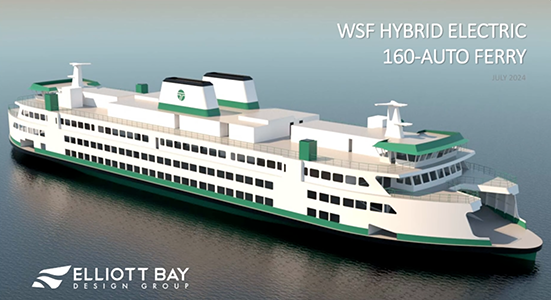||| FROM KING 5 TV |||
KING 5 got an exclusive look at new hybrid-electric Washington State Ferries (WSF) boat models.
The new boats will include charging units on the upper decks.
WSF leaders told KING 5 the new fleet will be the most reliable it’s ever been.
Regular ferry riders shared their frustrations with daily sailing delays and cancellations.
Some Vashon Island residents who were recently riding the King County Water Taxi said they’re opting for the “foot ferry” because they can’t always rely on the car ferry.
“We know that we’re not meeting expectations right now,” said Steve Nevey, WSF assistant secretary. “We do have plans in place to get there, it’s just going to take time and patience.”
WSF said the new hybrid-electric boats will offer more than one way to move people and cars across the water.
The 75-year-old ferry system is moving forward on its electrification plan.
People may be wondering why Washington state is not leading the way in operating a “green” fleet ahead of other systems across the country or around the world.
Nevey said there are a few reasons for that.
First, the original electrification plan was written just before the COVID-19 pandemic. A lot changed since then.
“We’re able to learn from mistakes [other ferry systems] made and things that they’re doing to make sure that we’re doing the right thing,” Nevey said. “I think the other thing is the technology evolves.”
Evolved technology is part of the new plan.
Major changes on board
Vessel charging receptacles will be on the upper bridge deck. Open-air passenger lounges beneath each pilothouse provide approximately 50 open-air seats per end.
WSF said a “high level of accessibility” will remain in place to meet all passengers’ needs.
The new hybrid-electric boats will have reduced topside structure to lower lifecycle cost.
Forty-seven feet of length will be added to the vessel near midship to allow for a 160-vehicle capacity. That is in comparison to 144-vehicle capacity on Olympic Class vessels – the most recent ferries added to the fleet between 2014-2018.
“The best ferry technology in the industry,” according to WSF, will be below deck.
A flexible hybrid propulsion plant that includes two diesel engines as well as two battery banks will power two electric motors on each end.
New boats will have rapid-charging technology to charge the batteries during each scheduled terminal stop.
All future WSF vessels will have three modes of operation – battery only, hybrid mode and a backup diesel mode.
WSF said the first five hybrid-electric vessels in the plan are expected to save a combined 240 million gallons of diesel over their 60-year lifespan.
These vessels are a major component of WSF’s System Electrification Plan, which will reduce our greenhouse gas emissions by 76% by the year 2040.
By 2050, WSF aims to be at a “zero emissions” status.
Electrification timeline
“In addition to making us greener, it grows our fleet to provide the level of service we need to deliver to the customers,” said Matt Von Ruden, WSF system electrification program administrator.
By the end of this year – WSF will know the number of builders it will work with to build the new fleet.
Contract awards will go out at the start of 2025.
“About a year after that, we would start construction and we plan to have the first vessels – hopefully, two vessels on the water in 2028,” Von Ruden said.
The plan is to have two more hybrid electric vessels on the water by 2029 and a fifth boat ready in 2030.
The first two boats will be on the Clinton-Mukilteo route and the second two boats will sail the Seattle-Bremerton route.
The fifth ferry will eventually grow the fleet from 21 to 26 total boats.
Six current ferries will be converted while 16 new boats are built.
Von Ruden said running hybrid-electric boats versus fully electric vessels is the best option.
“In battery-only mode, where we hope to operate most of the time, it’ll be simple bringing power from the electrical grid,” Von Ruden said. “In hybrid electric mode, the batteries, and the engines work together, the engine operates at peak efficiency all the time – when there’s extra power it sends it to the batteries.”
Von Ruden said ferry reliability will change drastically – and for the better.
The average age of boats in the current fleet is about 40 years old. The expectation is to keep a vessel in service for 60 years, which will be the same expectation for each new hybrid-electric ferry.
**If you are reading theOrcasonian for free, thank your fellow islanders. If you would like to support theOrcasonian CLICK HERE to set your modestly-priced, voluntary subscription. Otherwise, no worries; we’re happy to share with you.**









So, for the San Juan Islands, the ONLY county without road access, ZERO new boats are planned. Thanks Olympia.